HSO5005 Essay: Social Inclusion, Empowerment, Health and Social Care
VerifiedAdded on 2023/06/15
|11
|3740
|500
Essay
AI Summary
This essay provides an analysis of how various social issues impact health and social care, emphasizing the importance of empowerment and advocacy. It explores the concept of social inclusion and its significance in addressing societal problems that hinder individual growth. The essay discusses socio-economic factors, such as income, employment, and education, and their influence on health and well-being. It also examines the role of social groups in promoting social inclusion and delves into situations where the principles of social justice can be applied using sociological theories. Furthermore, the essay covers anti-oppressive approaches, highlighting the need to challenge inequality and promote self-awareness in social and health work, along with the impact of institutional racism and the importance of addressing discrimination against marginalized communities.
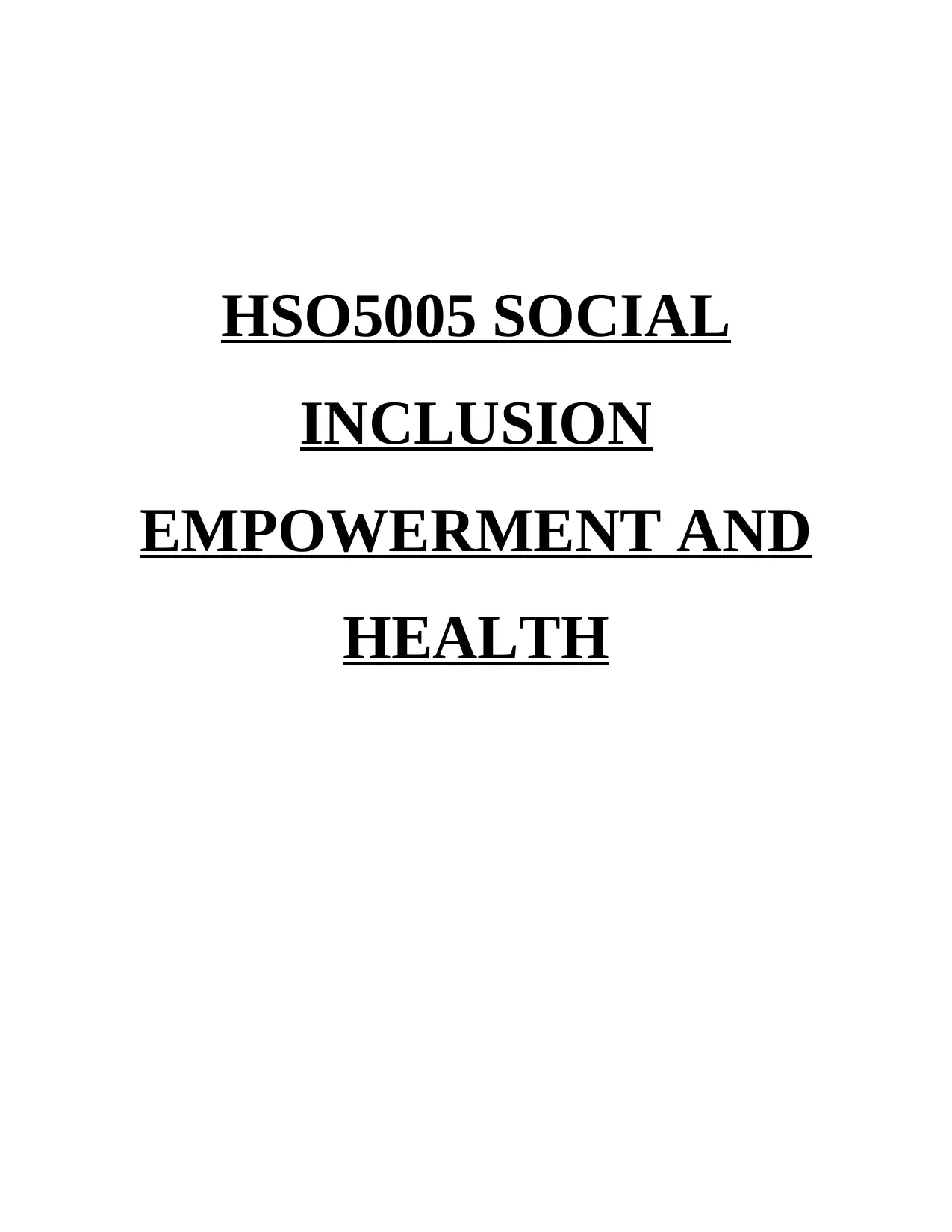
HSO5005 SOCIAL
INCLUSION
EMPOWERMENT AND
HEALTH
INCLUSION
EMPOWERMENT AND
HEALTH
Paraphrase This Document
Need a fresh take? Get an instant paraphrase of this document with our AI Paraphraser
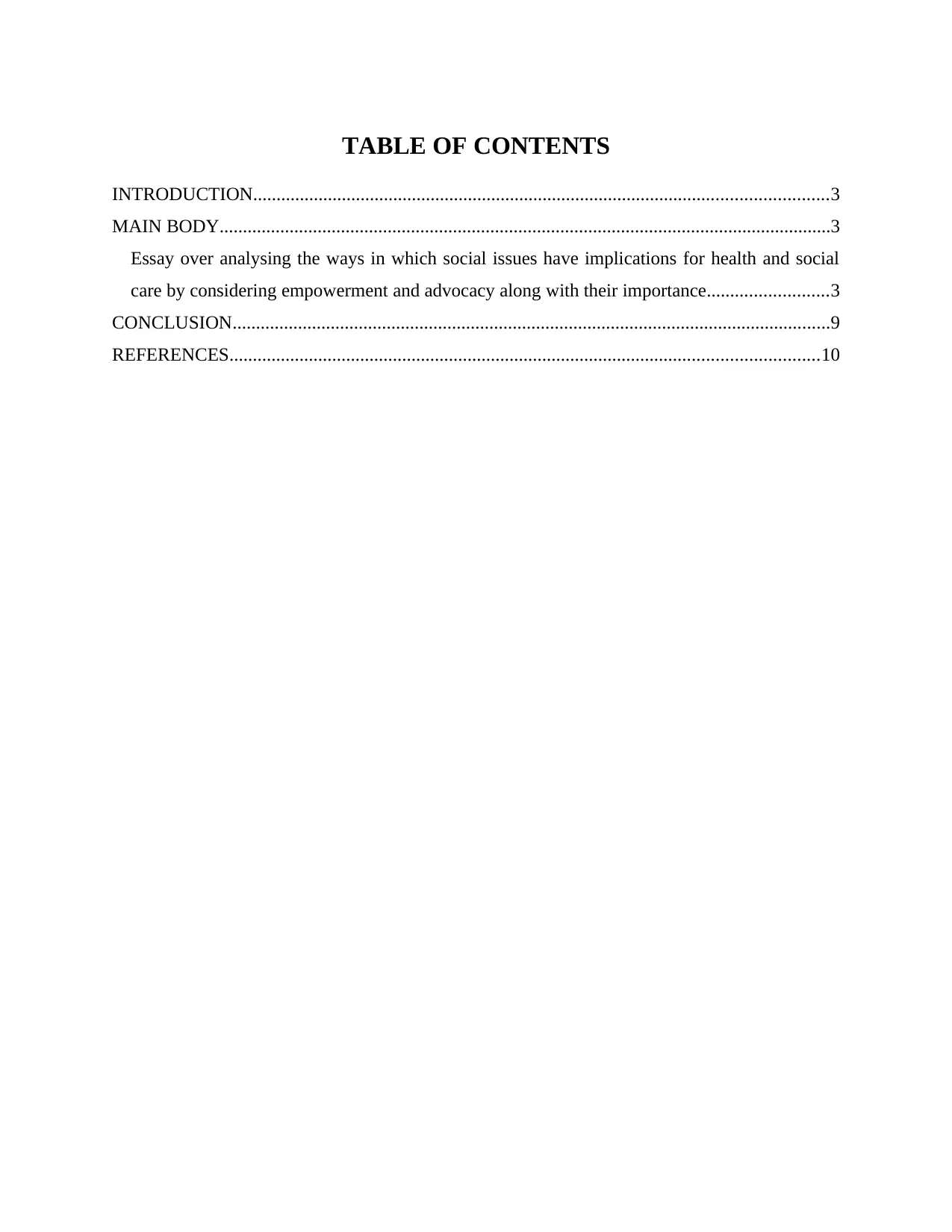
TABLE OF CONTENTS
INTRODUCTION...........................................................................................................................3
MAIN BODY...................................................................................................................................3
Essay over analysing the ways in which social issues have implications for health and social
care by considering empowerment and advocacy along with their importance..........................3
CONCLUSION................................................................................................................................9
REFERENCES..............................................................................................................................10
INTRODUCTION...........................................................................................................................3
MAIN BODY...................................................................................................................................3
Essay over analysing the ways in which social issues have implications for health and social
care by considering empowerment and advocacy along with their importance..........................3
CONCLUSION................................................................................................................................9
REFERENCES..............................................................................................................................10
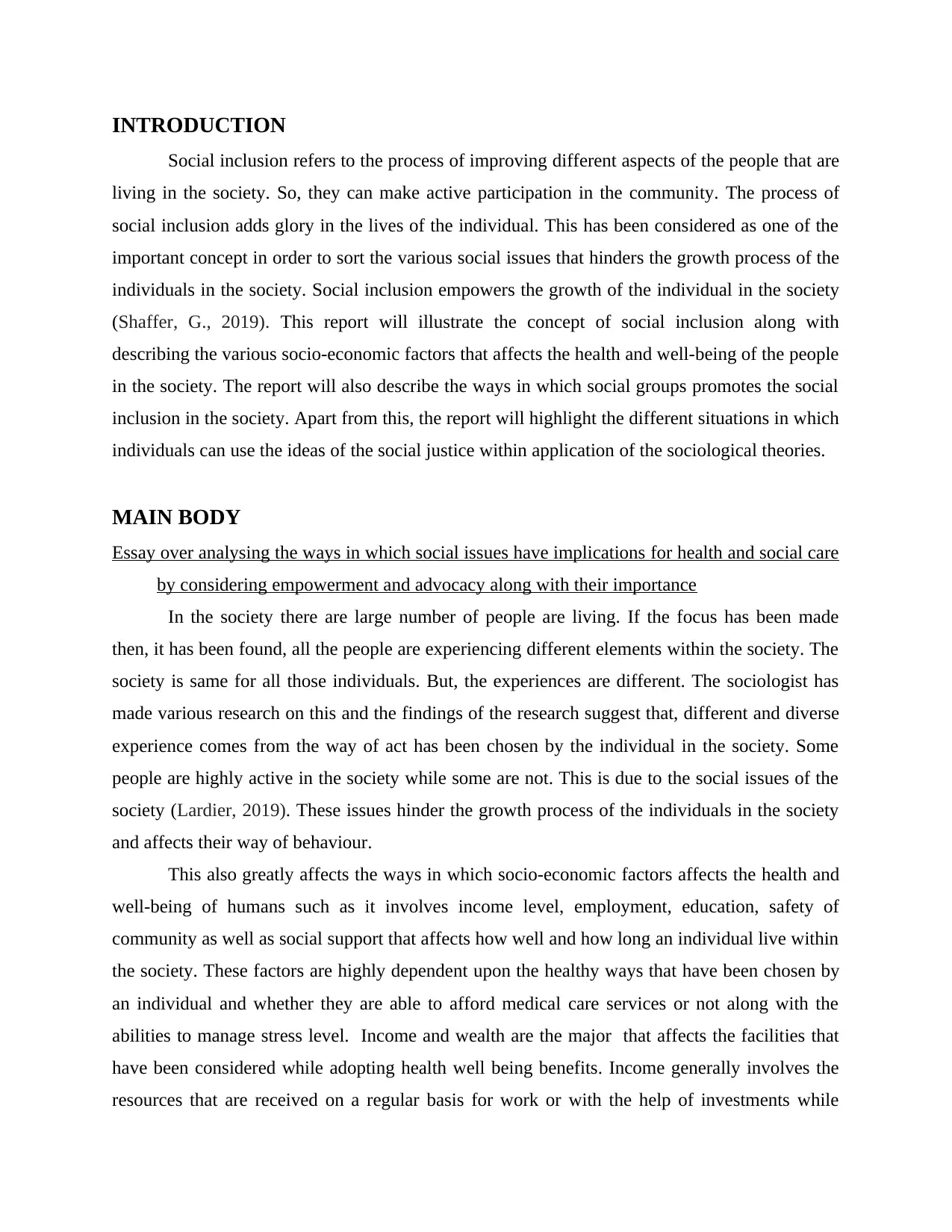
INTRODUCTION
Social inclusion refers to the process of improving different aspects of the people that are
living in the society. So, they can make active participation in the community. The process of
social inclusion adds glory in the lives of the individual. This has been considered as one of the
important concept in order to sort the various social issues that hinders the growth process of the
individuals in the society. Social inclusion empowers the growth of the individual in the society
(Shaffer, G., 2019). This report will illustrate the concept of social inclusion along with
describing the various socio-economic factors that affects the health and well-being of the people
in the society. The report will also describe the ways in which social groups promotes the social
inclusion in the society. Apart from this, the report will highlight the different situations in which
individuals can use the ideas of the social justice within application of the sociological theories.
MAIN BODY
Essay over analysing the ways in which social issues have implications for health and social care
by considering empowerment and advocacy along with their importance
In the society there are large number of people are living. If the focus has been made
then, it has been found, all the people are experiencing different elements within the society. The
society is same for all those individuals. But, the experiences are different. The sociologist has
made various research on this and the findings of the research suggest that, different and diverse
experience comes from the way of act has been chosen by the individual in the society. Some
people are highly active in the society while some are not. This is due to the social issues of the
society (Lardier, 2019). These issues hinder the growth process of the individuals in the society
and affects their way of behaviour.
This also greatly affects the ways in which socio-economic factors affects the health and
well-being of humans such as it involves income level, employment, education, safety of
community as well as social support that affects how well and how long an individual live within
the society. These factors are highly dependent upon the healthy ways that have been chosen by
an individual and whether they are able to afford medical care services or not along with the
abilities to manage stress level. Income and wealth are the major that affects the facilities that
have been considered while adopting health well being benefits. Income generally involves the
resources that are received on a regular basis for work or with the help of investments while
Social inclusion refers to the process of improving different aspects of the people that are
living in the society. So, they can make active participation in the community. The process of
social inclusion adds glory in the lives of the individual. This has been considered as one of the
important concept in order to sort the various social issues that hinders the growth process of the
individuals in the society. Social inclusion empowers the growth of the individual in the society
(Shaffer, G., 2019). This report will illustrate the concept of social inclusion along with
describing the various socio-economic factors that affects the health and well-being of the people
in the society. The report will also describe the ways in which social groups promotes the social
inclusion in the society. Apart from this, the report will highlight the different situations in which
individuals can use the ideas of the social justice within application of the sociological theories.
MAIN BODY
Essay over analysing the ways in which social issues have implications for health and social care
by considering empowerment and advocacy along with their importance
In the society there are large number of people are living. If the focus has been made
then, it has been found, all the people are experiencing different elements within the society. The
society is same for all those individuals. But, the experiences are different. The sociologist has
made various research on this and the findings of the research suggest that, different and diverse
experience comes from the way of act has been chosen by the individual in the society. Some
people are highly active in the society while some are not. This is due to the social issues of the
society (Lardier, 2019). These issues hinder the growth process of the individuals in the society
and affects their way of behaviour.
This also greatly affects the ways in which socio-economic factors affects the health and
well-being of humans such as it involves income level, employment, education, safety of
community as well as social support that affects how well and how long an individual live within
the society. These factors are highly dependent upon the healthy ways that have been chosen by
an individual and whether they are able to afford medical care services or not along with the
abilities to manage stress level. Income and wealth are the major that affects the facilities that
have been considered while adopting health well being benefits. Income generally involves the
resources that are received on a regular basis for work or with the help of investments while
⊘ This is a preview!⊘
Do you want full access?
Subscribe today to unlock all pages.

Trusted by 1+ million students worldwide
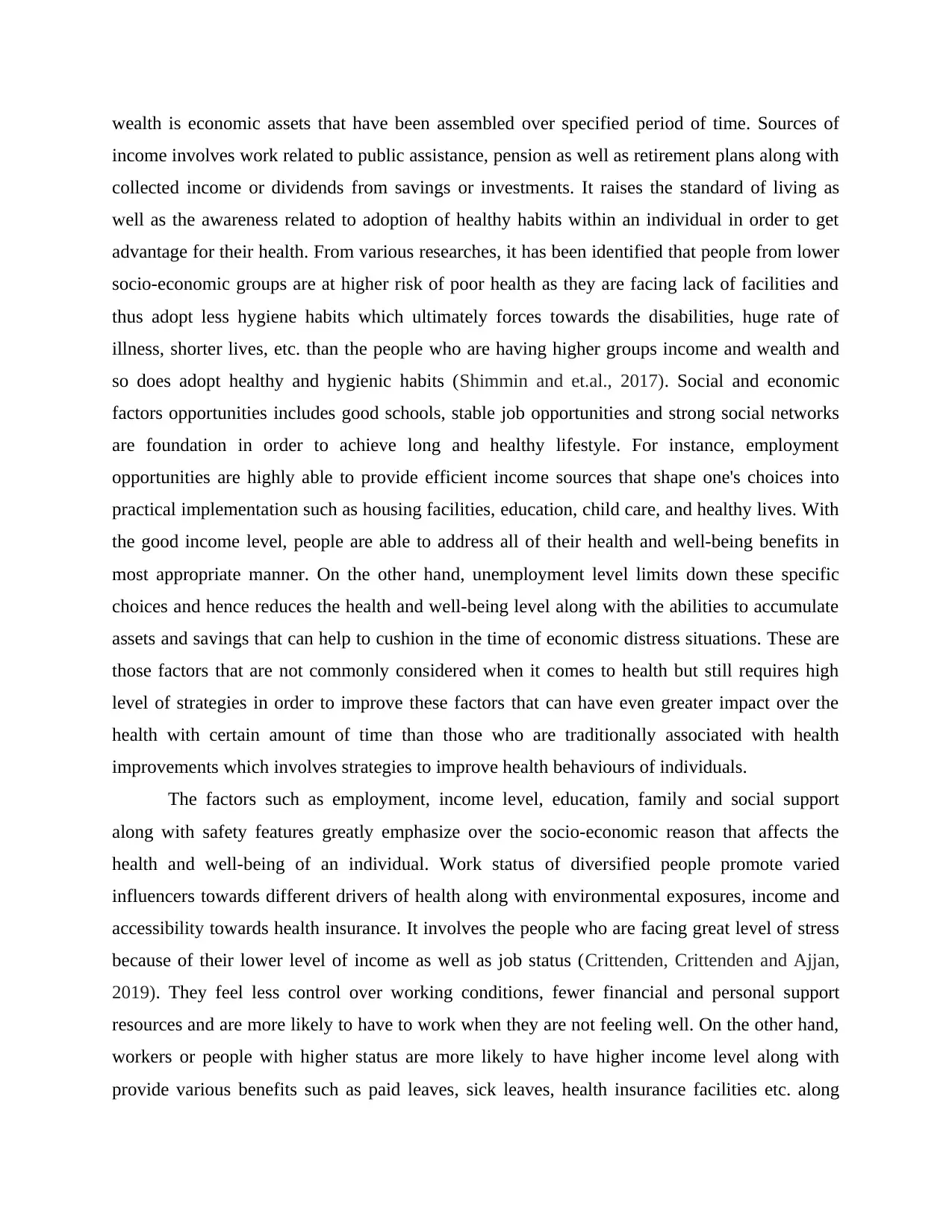
wealth is economic assets that have been assembled over specified period of time. Sources of
income involves work related to public assistance, pension as well as retirement plans along with
collected income or dividends from savings or investments. It raises the standard of living as
well as the awareness related to adoption of healthy habits within an individual in order to get
advantage for their health. From various researches, it has been identified that people from lower
socio-economic groups are at higher risk of poor health as they are facing lack of facilities and
thus adopt less hygiene habits which ultimately forces towards the disabilities, huge rate of
illness, shorter lives, etc. than the people who are having higher groups income and wealth and
so does adopt healthy and hygienic habits (Shimmin and et.al., 2017). Social and economic
factors opportunities includes good schools, stable job opportunities and strong social networks
are foundation in order to achieve long and healthy lifestyle. For instance, employment
opportunities are highly able to provide efficient income sources that shape one's choices into
practical implementation such as housing facilities, education, child care, and healthy lives. With
the good income level, people are able to address all of their health and well-being benefits in
most appropriate manner. On the other hand, unemployment level limits down these specific
choices and hence reduces the health and well-being level along with the abilities to accumulate
assets and savings that can help to cushion in the time of economic distress situations. These are
those factors that are not commonly considered when it comes to health but still requires high
level of strategies in order to improve these factors that can have even greater impact over the
health with certain amount of time than those who are traditionally associated with health
improvements which involves strategies to improve health behaviours of individuals.
The factors such as employment, income level, education, family and social support
along with safety features greatly emphasize over the socio-economic reason that affects the
health and well-being of an individual. Work status of diversified people promote varied
influencers towards different drivers of health along with environmental exposures, income and
accessibility towards health insurance. It involves the people who are facing great level of stress
because of their lower level of income as well as job status (Crittenden, Crittenden and Ajjan,
2019). They feel less control over working conditions, fewer financial and personal support
resources and are more likely to have to work when they are not feeling well. On the other hand,
workers or people with higher status are more likely to have higher income level along with
provide various benefits such as paid leaves, sick leaves, health insurance facilities etc. along
income involves work related to public assistance, pension as well as retirement plans along with
collected income or dividends from savings or investments. It raises the standard of living as
well as the awareness related to adoption of healthy habits within an individual in order to get
advantage for their health. From various researches, it has been identified that people from lower
socio-economic groups are at higher risk of poor health as they are facing lack of facilities and
thus adopt less hygiene habits which ultimately forces towards the disabilities, huge rate of
illness, shorter lives, etc. than the people who are having higher groups income and wealth and
so does adopt healthy and hygienic habits (Shimmin and et.al., 2017). Social and economic
factors opportunities includes good schools, stable job opportunities and strong social networks
are foundation in order to achieve long and healthy lifestyle. For instance, employment
opportunities are highly able to provide efficient income sources that shape one's choices into
practical implementation such as housing facilities, education, child care, and healthy lives. With
the good income level, people are able to address all of their health and well-being benefits in
most appropriate manner. On the other hand, unemployment level limits down these specific
choices and hence reduces the health and well-being level along with the abilities to accumulate
assets and savings that can help to cushion in the time of economic distress situations. These are
those factors that are not commonly considered when it comes to health but still requires high
level of strategies in order to improve these factors that can have even greater impact over the
health with certain amount of time than those who are traditionally associated with health
improvements which involves strategies to improve health behaviours of individuals.
The factors such as employment, income level, education, family and social support
along with safety features greatly emphasize over the socio-economic reason that affects the
health and well-being of an individual. Work status of diversified people promote varied
influencers towards different drivers of health along with environmental exposures, income and
accessibility towards health insurance. It involves the people who are facing great level of stress
because of their lower level of income as well as job status (Crittenden, Crittenden and Ajjan,
2019). They feel less control over working conditions, fewer financial and personal support
resources and are more likely to have to work when they are not feeling well. On the other hand,
workers or people with higher status are more likely to have higher income level along with
provide various benefits such as paid leaves, sick leaves, health insurance facilities etc. along
Paraphrase This Document
Need a fresh take? Get an instant paraphrase of this document with our AI Paraphraser
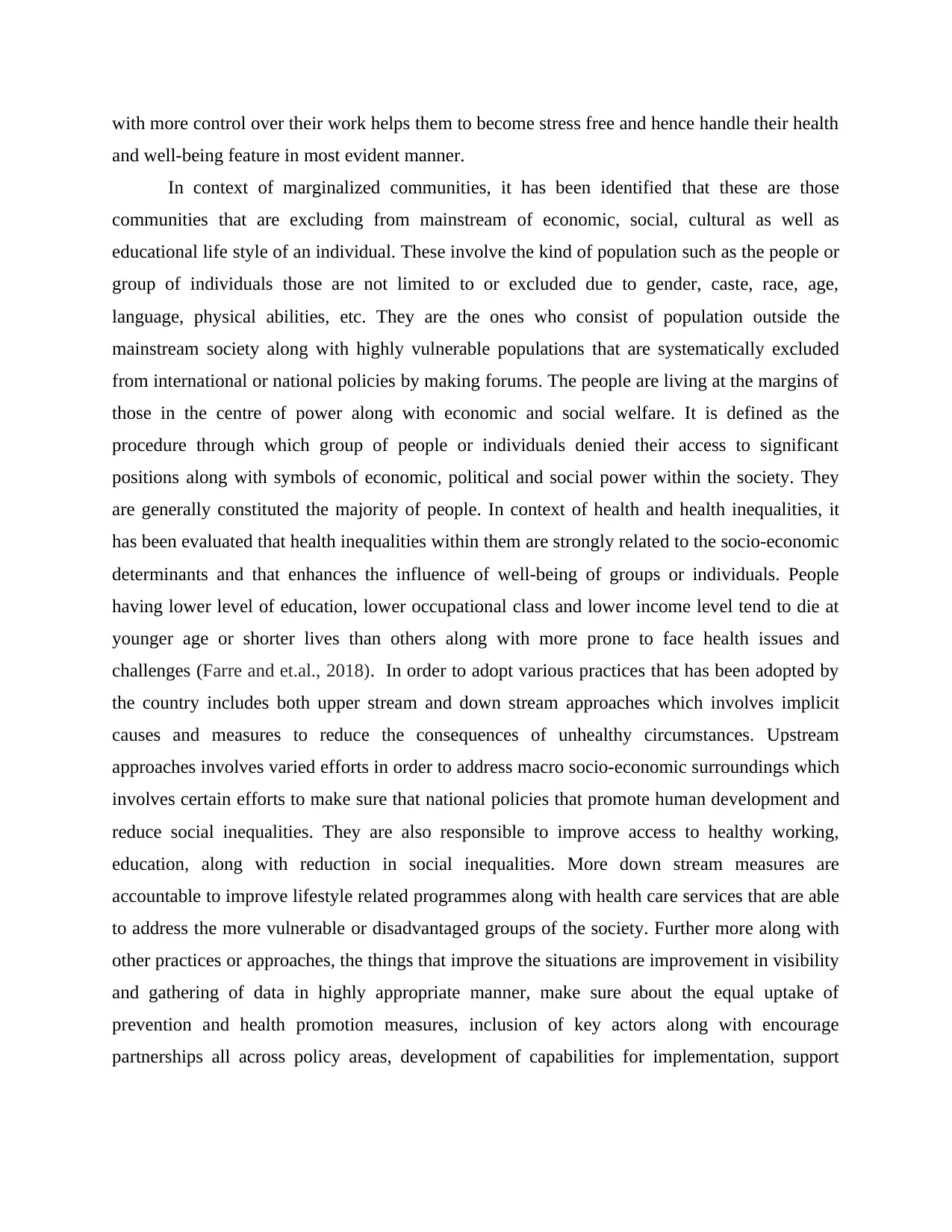
with more control over their work helps them to become stress free and hence handle their health
and well-being feature in most evident manner.
In context of marginalized communities, it has been identified that these are those
communities that are excluding from mainstream of economic, social, cultural as well as
educational life style of an individual. These involve the kind of population such as the people or
group of individuals those are not limited to or excluded due to gender, caste, race, age,
language, physical abilities, etc. They are the ones who consist of population outside the
mainstream society along with highly vulnerable populations that are systematically excluded
from international or national policies by making forums. The people are living at the margins of
those in the centre of power along with economic and social welfare. It is defined as the
procedure through which group of people or individuals denied their access to significant
positions along with symbols of economic, political and social power within the society. They
are generally constituted the majority of people. In context of health and health inequalities, it
has been evaluated that health inequalities within them are strongly related to the socio-economic
determinants and that enhances the influence of well-being of groups or individuals. People
having lower level of education, lower occupational class and lower income level tend to die at
younger age or shorter lives than others along with more prone to face health issues and
challenges (Farre and et.al., 2018). In order to adopt various practices that has been adopted by
the country includes both upper stream and down stream approaches which involves implicit
causes and measures to reduce the consequences of unhealthy circumstances. Upstream
approaches involves varied efforts in order to address macro socio-economic surroundings which
involves certain efforts to make sure that national policies that promote human development and
reduce social inequalities. They are also responsible to improve access to healthy working,
education, along with reduction in social inequalities. More down stream measures are
accountable to improve lifestyle related programmes along with health care services that are able
to address the more vulnerable or disadvantaged groups of the society. Further more along with
other practices or approaches, the things that improve the situations are improvement in visibility
and gathering of data in highly appropriate manner, make sure about the equal uptake of
prevention and health promotion measures, inclusion of key actors along with encourage
partnerships all across policy areas, development of capabilities for implementation, support
and well-being feature in most evident manner.
In context of marginalized communities, it has been identified that these are those
communities that are excluding from mainstream of economic, social, cultural as well as
educational life style of an individual. These involve the kind of population such as the people or
group of individuals those are not limited to or excluded due to gender, caste, race, age,
language, physical abilities, etc. They are the ones who consist of population outside the
mainstream society along with highly vulnerable populations that are systematically excluded
from international or national policies by making forums. The people are living at the margins of
those in the centre of power along with economic and social welfare. It is defined as the
procedure through which group of people or individuals denied their access to significant
positions along with symbols of economic, political and social power within the society. They
are generally constituted the majority of people. In context of health and health inequalities, it
has been evaluated that health inequalities within them are strongly related to the socio-economic
determinants and that enhances the influence of well-being of groups or individuals. People
having lower level of education, lower occupational class and lower income level tend to die at
younger age or shorter lives than others along with more prone to face health issues and
challenges (Farre and et.al., 2018). In order to adopt various practices that has been adopted by
the country includes both upper stream and down stream approaches which involves implicit
causes and measures to reduce the consequences of unhealthy circumstances. Upstream
approaches involves varied efforts in order to address macro socio-economic surroundings which
involves certain efforts to make sure that national policies that promote human development and
reduce social inequalities. They are also responsible to improve access to healthy working,
education, along with reduction in social inequalities. More down stream measures are
accountable to improve lifestyle related programmes along with health care services that are able
to address the more vulnerable or disadvantaged groups of the society. Further more along with
other practices or approaches, the things that improve the situations are improvement in visibility
and gathering of data in highly appropriate manner, make sure about the equal uptake of
prevention and health promotion measures, inclusion of key actors along with encourage
partnerships all across policy areas, development of capabilities for implementation, support
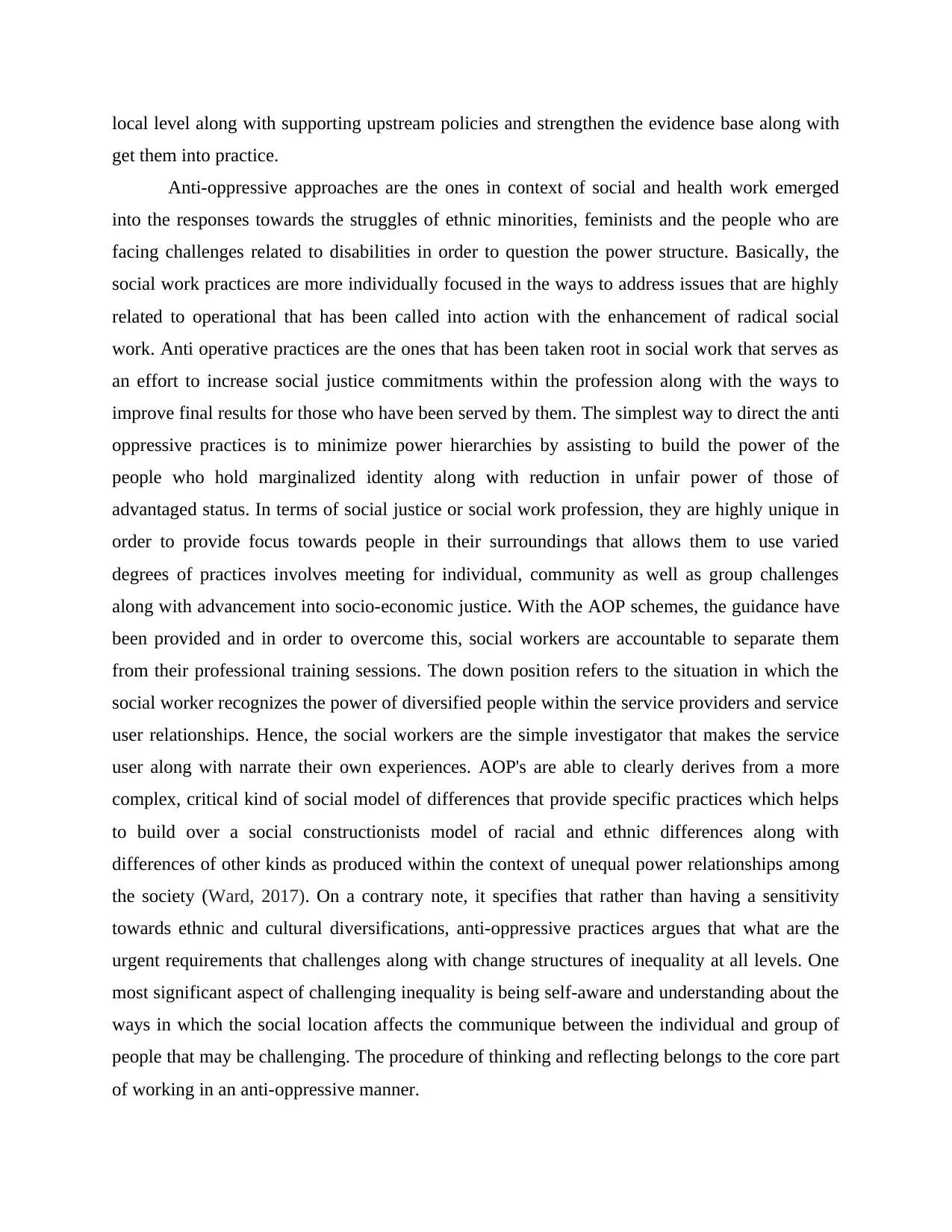
local level along with supporting upstream policies and strengthen the evidence base along with
get them into practice.
Anti-oppressive approaches are the ones in context of social and health work emerged
into the responses towards the struggles of ethnic minorities, feminists and the people who are
facing challenges related to disabilities in order to question the power structure. Basically, the
social work practices are more individually focused in the ways to address issues that are highly
related to operational that has been called into action with the enhancement of radical social
work. Anti operative practices are the ones that has been taken root in social work that serves as
an effort to increase social justice commitments within the profession along with the ways to
improve final results for those who have been served by them. The simplest way to direct the anti
oppressive practices is to minimize power hierarchies by assisting to build the power of the
people who hold marginalized identity along with reduction in unfair power of those of
advantaged status. In terms of social justice or social work profession, they are highly unique in
order to provide focus towards people in their surroundings that allows them to use varied
degrees of practices involves meeting for individual, community as well as group challenges
along with advancement into socio-economic justice. With the AOP schemes, the guidance have
been provided and in order to overcome this, social workers are accountable to separate them
from their professional training sessions. The down position refers to the situation in which the
social worker recognizes the power of diversified people within the service providers and service
user relationships. Hence, the social workers are the simple investigator that makes the service
user along with narrate their own experiences. AOP's are able to clearly derives from a more
complex, critical kind of social model of differences that provide specific practices which helps
to build over a social constructionists model of racial and ethnic differences along with
differences of other kinds as produced within the context of unequal power relationships among
the society (Ward, 2017). On a contrary note, it specifies that rather than having a sensitivity
towards ethnic and cultural diversifications, anti-oppressive practices argues that what are the
urgent requirements that challenges along with change structures of inequality at all levels. One
most significant aspect of challenging inequality is being self-aware and understanding about the
ways in which the social location affects the communique between the individual and group of
people that may be challenging. The procedure of thinking and reflecting belongs to the core part
of working in an anti-oppressive manner.
get them into practice.
Anti-oppressive approaches are the ones in context of social and health work emerged
into the responses towards the struggles of ethnic minorities, feminists and the people who are
facing challenges related to disabilities in order to question the power structure. Basically, the
social work practices are more individually focused in the ways to address issues that are highly
related to operational that has been called into action with the enhancement of radical social
work. Anti operative practices are the ones that has been taken root in social work that serves as
an effort to increase social justice commitments within the profession along with the ways to
improve final results for those who have been served by them. The simplest way to direct the anti
oppressive practices is to minimize power hierarchies by assisting to build the power of the
people who hold marginalized identity along with reduction in unfair power of those of
advantaged status. In terms of social justice or social work profession, they are highly unique in
order to provide focus towards people in their surroundings that allows them to use varied
degrees of practices involves meeting for individual, community as well as group challenges
along with advancement into socio-economic justice. With the AOP schemes, the guidance have
been provided and in order to overcome this, social workers are accountable to separate them
from their professional training sessions. The down position refers to the situation in which the
social worker recognizes the power of diversified people within the service providers and service
user relationships. Hence, the social workers are the simple investigator that makes the service
user along with narrate their own experiences. AOP's are able to clearly derives from a more
complex, critical kind of social model of differences that provide specific practices which helps
to build over a social constructionists model of racial and ethnic differences along with
differences of other kinds as produced within the context of unequal power relationships among
the society (Ward, 2017). On a contrary note, it specifies that rather than having a sensitivity
towards ethnic and cultural diversifications, anti-oppressive practices argues that what are the
urgent requirements that challenges along with change structures of inequality at all levels. One
most significant aspect of challenging inequality is being self-aware and understanding about the
ways in which the social location affects the communique between the individual and group of
people that may be challenging. The procedure of thinking and reflecting belongs to the core part
of working in an anti-oppressive manner.
⊘ This is a preview!⊘
Do you want full access?
Subscribe today to unlock all pages.

Trusted by 1+ million students worldwide
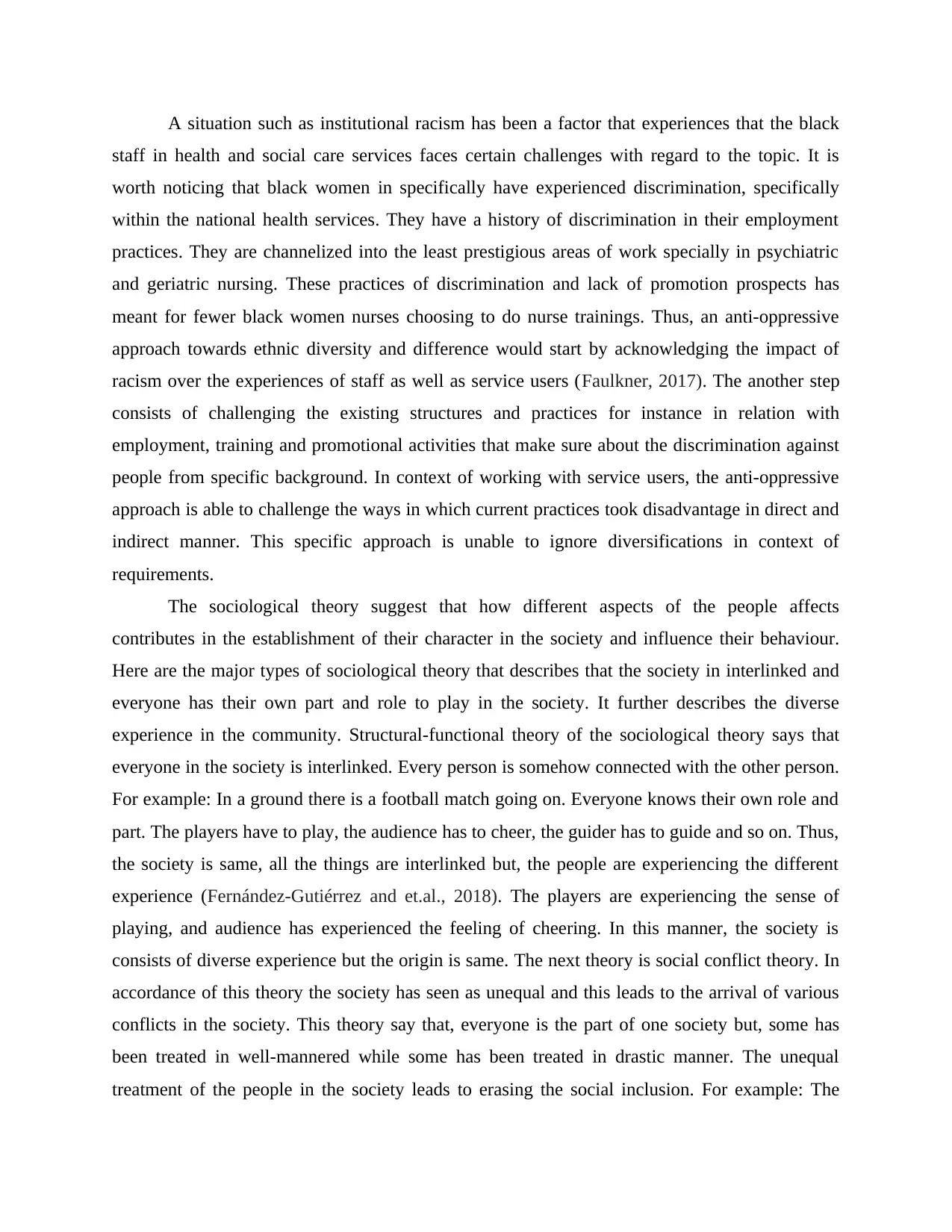
A situation such as institutional racism has been a factor that experiences that the black
staff in health and social care services faces certain challenges with regard to the topic. It is
worth noticing that black women in specifically have experienced discrimination, specifically
within the national health services. They have a history of discrimination in their employment
practices. They are channelized into the least prestigious areas of work specially in psychiatric
and geriatric nursing. These practices of discrimination and lack of promotion prospects has
meant for fewer black women nurses choosing to do nurse trainings. Thus, an anti-oppressive
approach towards ethnic diversity and difference would start by acknowledging the impact of
racism over the experiences of staff as well as service users (Faulkner, 2017). The another step
consists of challenging the existing structures and practices for instance in relation with
employment, training and promotional activities that make sure about the discrimination against
people from specific background. In context of working with service users, the anti-oppressive
approach is able to challenge the ways in which current practices took disadvantage in direct and
indirect manner. This specific approach is unable to ignore diversifications in context of
requirements.
The sociological theory suggest that how different aspects of the people affects
contributes in the establishment of their character in the society and influence their behaviour.
Here are the major types of sociological theory that describes that the society in interlinked and
everyone has their own part and role to play in the society. It further describes the diverse
experience in the community. Structural-functional theory of the sociological theory says that
everyone in the society is interlinked. Every person is somehow connected with the other person.
For example: In a ground there is a football match going on. Everyone knows their own role and
part. The players have to play, the audience has to cheer, the guider has to guide and so on. Thus,
the society is same, all the things are interlinked but, the people are experiencing the different
experience (Fernández‐Gutiérrez and et.al., 2018). The players are experiencing the sense of
playing, and audience has experienced the feeling of cheering. In this manner, the society is
consists of diverse experience but the origin is same. The next theory is social conflict theory. In
accordance of this theory the society has seen as unequal and this leads to the arrival of various
conflicts in the society. This theory say that, everyone is the part of one society but, some has
been treated in well-mannered while some has been treated in drastic manner. The unequal
treatment of the people in the society leads to erasing the social inclusion. For example: The
staff in health and social care services faces certain challenges with regard to the topic. It is
worth noticing that black women in specifically have experienced discrimination, specifically
within the national health services. They have a history of discrimination in their employment
practices. They are channelized into the least prestigious areas of work specially in psychiatric
and geriatric nursing. These practices of discrimination and lack of promotion prospects has
meant for fewer black women nurses choosing to do nurse trainings. Thus, an anti-oppressive
approach towards ethnic diversity and difference would start by acknowledging the impact of
racism over the experiences of staff as well as service users (Faulkner, 2017). The another step
consists of challenging the existing structures and practices for instance in relation with
employment, training and promotional activities that make sure about the discrimination against
people from specific background. In context of working with service users, the anti-oppressive
approach is able to challenge the ways in which current practices took disadvantage in direct and
indirect manner. This specific approach is unable to ignore diversifications in context of
requirements.
The sociological theory suggest that how different aspects of the people affects
contributes in the establishment of their character in the society and influence their behaviour.
Here are the major types of sociological theory that describes that the society in interlinked and
everyone has their own part and role to play in the society. It further describes the diverse
experience in the community. Structural-functional theory of the sociological theory says that
everyone in the society is interlinked. Every person is somehow connected with the other person.
For example: In a ground there is a football match going on. Everyone knows their own role and
part. The players have to play, the audience has to cheer, the guider has to guide and so on. Thus,
the society is same, all the things are interlinked but, the people are experiencing the different
experience (Fernández‐Gutiérrez and et.al., 2018). The players are experiencing the sense of
playing, and audience has experienced the feeling of cheering. In this manner, the society is
consists of diverse experience but the origin is same. The next theory is social conflict theory. In
accordance of this theory the society has seen as unequal and this leads to the arrival of various
conflicts in the society. This theory say that, everyone is the part of one society but, some has
been treated in well-mannered while some has been treated in drastic manner. The unequal
treatment of the people in the society leads to erasing the social inclusion. For example: The
Paraphrase This Document
Need a fresh take? Get an instant paraphrase of this document with our AI Paraphraser
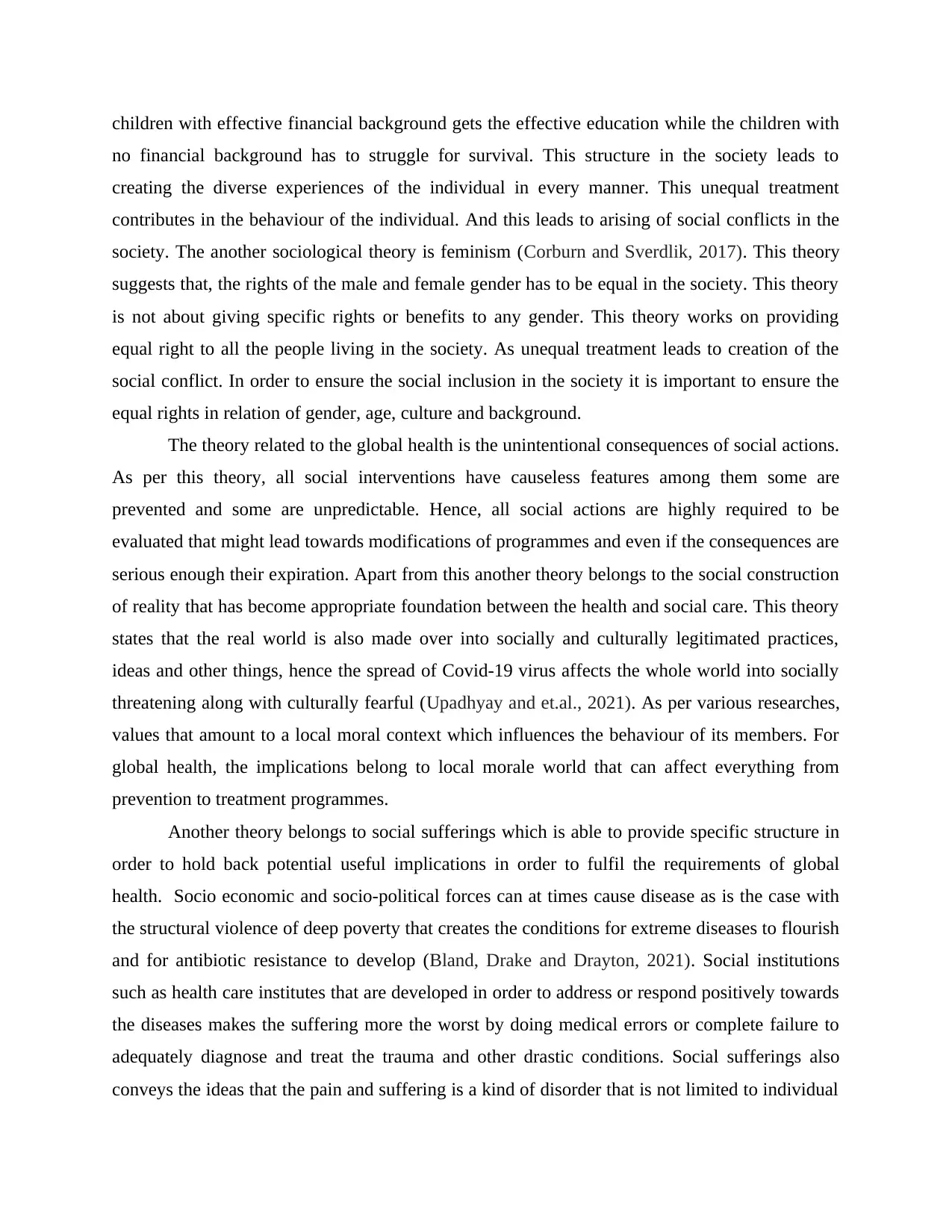
children with effective financial background gets the effective education while the children with
no financial background has to struggle for survival. This structure in the society leads to
creating the diverse experiences of the individual in every manner. This unequal treatment
contributes in the behaviour of the individual. And this leads to arising of social conflicts in the
society. The another sociological theory is feminism (Corburn and Sverdlik, 2017). This theory
suggests that, the rights of the male and female gender has to be equal in the society. This theory
is not about giving specific rights or benefits to any gender. This theory works on providing
equal right to all the people living in the society. As unequal treatment leads to creation of the
social conflict. In order to ensure the social inclusion in the society it is important to ensure the
equal rights in relation of gender, age, culture and background.
The theory related to the global health is the unintentional consequences of social actions.
As per this theory, all social interventions have causeless features among them some are
prevented and some are unpredictable. Hence, all social actions are highly required to be
evaluated that might lead towards modifications of programmes and even if the consequences are
serious enough their expiration. Apart from this another theory belongs to the social construction
of reality that has become appropriate foundation between the health and social care. This theory
states that the real world is also made over into socially and culturally legitimated practices,
ideas and other things, hence the spread of Covid-19 virus affects the whole world into socially
threatening along with culturally fearful (Upadhyay and et.al., 2021). As per various researches,
values that amount to a local moral context which influences the behaviour of its members. For
global health, the implications belong to local morale world that can affect everything from
prevention to treatment programmes.
Another theory belongs to social sufferings which is able to provide specific structure in
order to hold back potential useful implications in order to fulfil the requirements of global
health. Socio economic and socio-political forces can at times cause disease as is the case with
the structural violence of deep poverty that creates the conditions for extreme diseases to flourish
and for antibiotic resistance to develop (Bland, Drake and Drayton, 2021). Social institutions
such as health care institutes that are developed in order to address or respond positively towards
the diseases makes the suffering more the worst by doing medical errors or complete failure to
adequately diagnose and treat the trauma and other drastic conditions. Social sufferings also
conveys the ideas that the pain and suffering is a kind of disorder that is not limited to individual
no financial background has to struggle for survival. This structure in the society leads to
creating the diverse experiences of the individual in every manner. This unequal treatment
contributes in the behaviour of the individual. And this leads to arising of social conflicts in the
society. The another sociological theory is feminism (Corburn and Sverdlik, 2017). This theory
suggests that, the rights of the male and female gender has to be equal in the society. This theory
is not about giving specific rights or benefits to any gender. This theory works on providing
equal right to all the people living in the society. As unequal treatment leads to creation of the
social conflict. In order to ensure the social inclusion in the society it is important to ensure the
equal rights in relation of gender, age, culture and background.
The theory related to the global health is the unintentional consequences of social actions.
As per this theory, all social interventions have causeless features among them some are
prevented and some are unpredictable. Hence, all social actions are highly required to be
evaluated that might lead towards modifications of programmes and even if the consequences are
serious enough their expiration. Apart from this another theory belongs to the social construction
of reality that has become appropriate foundation between the health and social care. This theory
states that the real world is also made over into socially and culturally legitimated practices,
ideas and other things, hence the spread of Covid-19 virus affects the whole world into socially
threatening along with culturally fearful (Upadhyay and et.al., 2021). As per various researches,
values that amount to a local moral context which influences the behaviour of its members. For
global health, the implications belong to local morale world that can affect everything from
prevention to treatment programmes.
Another theory belongs to social sufferings which is able to provide specific structure in
order to hold back potential useful implications in order to fulfil the requirements of global
health. Socio economic and socio-political forces can at times cause disease as is the case with
the structural violence of deep poverty that creates the conditions for extreme diseases to flourish
and for antibiotic resistance to develop (Bland, Drake and Drayton, 2021). Social institutions
such as health care institutes that are developed in order to address or respond positively towards
the diseases makes the suffering more the worst by doing medical errors or complete failure to
adequately diagnose and treat the trauma and other drastic conditions. Social sufferings also
conveys the ideas that the pain and suffering is a kind of disorder that is not limited to individual
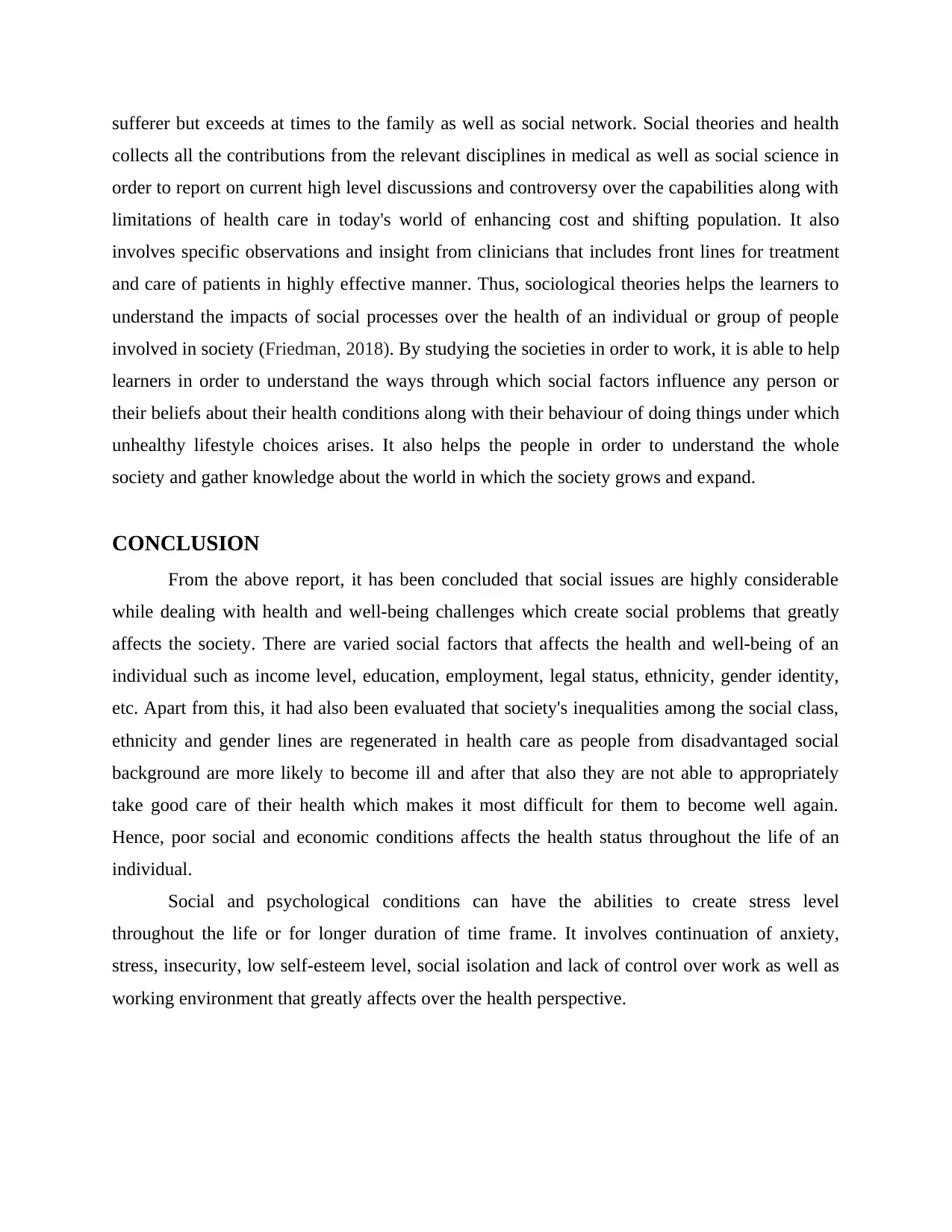
sufferer but exceeds at times to the family as well as social network. Social theories and health
collects all the contributions from the relevant disciplines in medical as well as social science in
order to report on current high level discussions and controversy over the capabilities along with
limitations of health care in today's world of enhancing cost and shifting population. It also
involves specific observations and insight from clinicians that includes front lines for treatment
and care of patients in highly effective manner. Thus, sociological theories helps the learners to
understand the impacts of social processes over the health of an individual or group of people
involved in society (Friedman, 2018). By studying the societies in order to work, it is able to help
learners in order to understand the ways through which social factors influence any person or
their beliefs about their health conditions along with their behaviour of doing things under which
unhealthy lifestyle choices arises. It also helps the people in order to understand the whole
society and gather knowledge about the world in which the society grows and expand.
CONCLUSION
From the above report, it has been concluded that social issues are highly considerable
while dealing with health and well-being challenges which create social problems that greatly
affects the society. There are varied social factors that affects the health and well-being of an
individual such as income level, education, employment, legal status, ethnicity, gender identity,
etc. Apart from this, it had also been evaluated that society's inequalities among the social class,
ethnicity and gender lines are regenerated in health care as people from disadvantaged social
background are more likely to become ill and after that also they are not able to appropriately
take good care of their health which makes it most difficult for them to become well again.
Hence, poor social and economic conditions affects the health status throughout the life of an
individual.
Social and psychological conditions can have the abilities to create stress level
throughout the life or for longer duration of time frame. It involves continuation of anxiety,
stress, insecurity, low self-esteem level, social isolation and lack of control over work as well as
working environment that greatly affects over the health perspective.
collects all the contributions from the relevant disciplines in medical as well as social science in
order to report on current high level discussions and controversy over the capabilities along with
limitations of health care in today's world of enhancing cost and shifting population. It also
involves specific observations and insight from clinicians that includes front lines for treatment
and care of patients in highly effective manner. Thus, sociological theories helps the learners to
understand the impacts of social processes over the health of an individual or group of people
involved in society (Friedman, 2018). By studying the societies in order to work, it is able to help
learners in order to understand the ways through which social factors influence any person or
their beliefs about their health conditions along with their behaviour of doing things under which
unhealthy lifestyle choices arises. It also helps the people in order to understand the whole
society and gather knowledge about the world in which the society grows and expand.
CONCLUSION
From the above report, it has been concluded that social issues are highly considerable
while dealing with health and well-being challenges which create social problems that greatly
affects the society. There are varied social factors that affects the health and well-being of an
individual such as income level, education, employment, legal status, ethnicity, gender identity,
etc. Apart from this, it had also been evaluated that society's inequalities among the social class,
ethnicity and gender lines are regenerated in health care as people from disadvantaged social
background are more likely to become ill and after that also they are not able to appropriately
take good care of their health which makes it most difficult for them to become well again.
Hence, poor social and economic conditions affects the health status throughout the life of an
individual.
Social and psychological conditions can have the abilities to create stress level
throughout the life or for longer duration of time frame. It involves continuation of anxiety,
stress, insecurity, low self-esteem level, social isolation and lack of control over work as well as
working environment that greatly affects over the health perspective.
⊘ This is a preview!⊘
Do you want full access?
Subscribe today to unlock all pages.

Trusted by 1+ million students worldwide
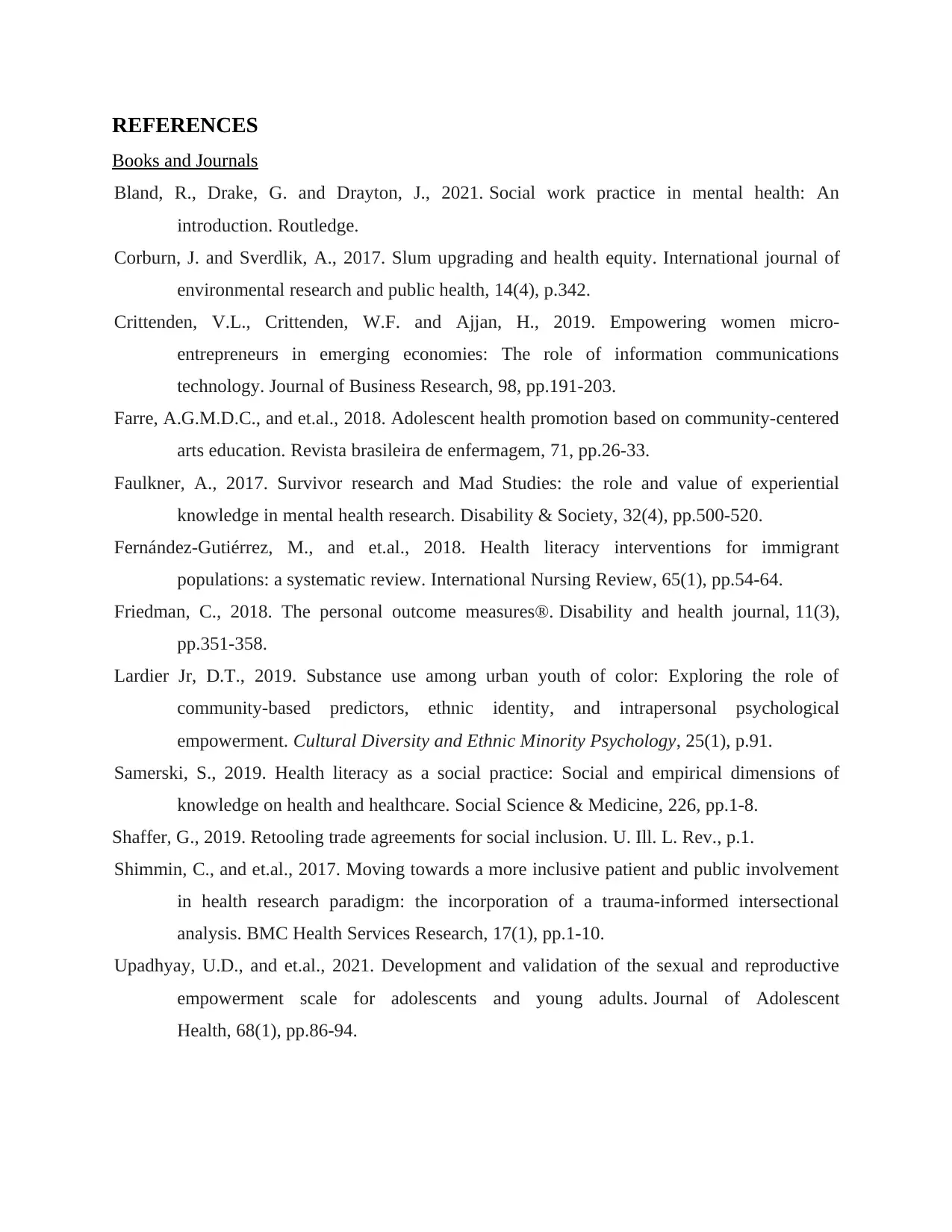
REFERENCES
Books and Journals
Bland, R., Drake, G. and Drayton, J., 2021. Social work practice in mental health: An
introduction. Routledge.
Corburn, J. and Sverdlik, A., 2017. Slum upgrading and health equity. International journal of
environmental research and public health, 14(4), p.342.
Crittenden, V.L., Crittenden, W.F. and Ajjan, H., 2019. Empowering women micro-
entrepreneurs in emerging economies: The role of information communications
technology. Journal of Business Research, 98, pp.191-203.
Farre, A.G.M.D.C., and et.al., 2018. Adolescent health promotion based on community-centered
arts education. Revista brasileira de enfermagem, 71, pp.26-33.
Faulkner, A., 2017. Survivor research and Mad Studies: the role and value of experiential
knowledge in mental health research. Disability & Society, 32(4), pp.500-520.
Fernández‐Gutiérrez, M., and et.al., 2018. Health literacy interventions for immigrant
populations: a systematic review. International Nursing Review, 65(1), pp.54-64.
Friedman, C., 2018. The personal outcome measures®. Disability and health journal, 11(3),
pp.351-358.
Lardier Jr, D.T., 2019. Substance use among urban youth of color: Exploring the role of
community-based predictors, ethnic identity, and intrapersonal psychological
empowerment. Cultural Diversity and Ethnic Minority Psychology, 25(1), p.91.
Samerski, S., 2019. Health literacy as a social practice: Social and empirical dimensions of
knowledge on health and healthcare. Social Science & Medicine, 226, pp.1-8.
Shaffer, G., 2019. Retooling trade agreements for social inclusion. U. Ill. L. Rev., p.1.
Shimmin, C., and et.al., 2017. Moving towards a more inclusive patient and public involvement
in health research paradigm: the incorporation of a trauma-informed intersectional
analysis. BMC Health Services Research, 17(1), pp.1-10.
Upadhyay, U.D., and et.al., 2021. Development and validation of the sexual and reproductive
empowerment scale for adolescents and young adults. Journal of Adolescent
Health, 68(1), pp.86-94.
Books and Journals
Bland, R., Drake, G. and Drayton, J., 2021. Social work practice in mental health: An
introduction. Routledge.
Corburn, J. and Sverdlik, A., 2017. Slum upgrading and health equity. International journal of
environmental research and public health, 14(4), p.342.
Crittenden, V.L., Crittenden, W.F. and Ajjan, H., 2019. Empowering women micro-
entrepreneurs in emerging economies: The role of information communications
technology. Journal of Business Research, 98, pp.191-203.
Farre, A.G.M.D.C., and et.al., 2018. Adolescent health promotion based on community-centered
arts education. Revista brasileira de enfermagem, 71, pp.26-33.
Faulkner, A., 2017. Survivor research and Mad Studies: the role and value of experiential
knowledge in mental health research. Disability & Society, 32(4), pp.500-520.
Fernández‐Gutiérrez, M., and et.al., 2018. Health literacy interventions for immigrant
populations: a systematic review. International Nursing Review, 65(1), pp.54-64.
Friedman, C., 2018. The personal outcome measures®. Disability and health journal, 11(3),
pp.351-358.
Lardier Jr, D.T., 2019. Substance use among urban youth of color: Exploring the role of
community-based predictors, ethnic identity, and intrapersonal psychological
empowerment. Cultural Diversity and Ethnic Minority Psychology, 25(1), p.91.
Samerski, S., 2019. Health literacy as a social practice: Social and empirical dimensions of
knowledge on health and healthcare. Social Science & Medicine, 226, pp.1-8.
Shaffer, G., 2019. Retooling trade agreements for social inclusion. U. Ill. L. Rev., p.1.
Shimmin, C., and et.al., 2017. Moving towards a more inclusive patient and public involvement
in health research paradigm: the incorporation of a trauma-informed intersectional
analysis. BMC Health Services Research, 17(1), pp.1-10.
Upadhyay, U.D., and et.al., 2021. Development and validation of the sexual and reproductive
empowerment scale for adolescents and young adults. Journal of Adolescent
Health, 68(1), pp.86-94.
Paraphrase This Document
Need a fresh take? Get an instant paraphrase of this document with our AI Paraphraser
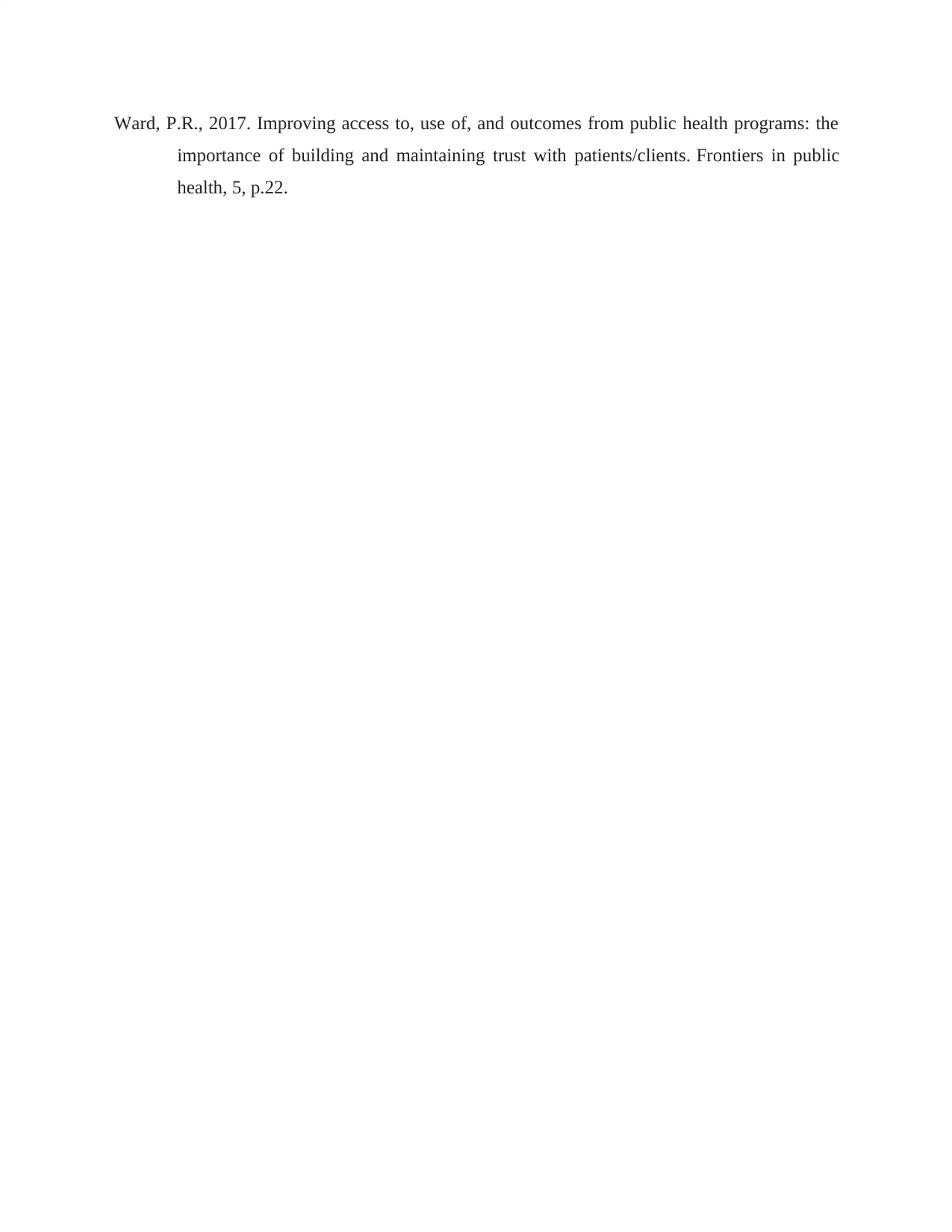
Ward, P.R., 2017. Improving access to, use of, and outcomes from public health programs: the
importance of building and maintaining trust with patients/clients. Frontiers in public
health, 5, p.22.
importance of building and maintaining trust with patients/clients. Frontiers in public
health, 5, p.22.
1 out of 11
Related Documents
Your All-in-One AI-Powered Toolkit for Academic Success.
+13062052269
info@desklib.com
Available 24*7 on WhatsApp / Email
![[object Object]](/_next/static/media/star-bottom.7253800d.svg)
Unlock your academic potential
Copyright © 2020–2025 A2Z Services. All Rights Reserved. Developed and managed by ZUCOL.




